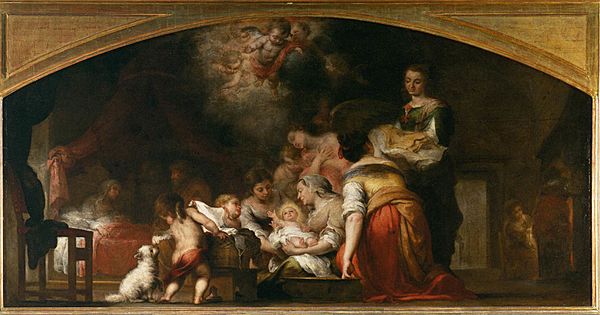The Birth of the Virgin (Murillo) facts for kids
The Birth of the Virgin is a famous painting from 1661 by the Spanish artist Bartolomé Esteban Murillo. It shows the special moment when the Virgin Mary, an important figure in Christianity, was born. This painting is known for looking very real, almost like a snapshot of everyday life.
Contents
History of the Painting
Where the Painting Was First Placed
Murillo painted The Birth of the Virgin for a special place. It was made for the Chapel of the Immaculate Conception inside Seville Cathedral in Spain. This was a very important church.
How the Painting Moved to France
Later, during a war, French soldiers led by Marshal Jean de Dieu Soult took the painting. They also took another painting by Murillo called Immaculate Conception. The French originally wanted a different painting, The Vision of Saint Anthony of Padua. But the city leaders of Seville suggested they take The Birth of the Virgin instead. This is how the painting left the chapel.
Where to See It Now
Today, The Birth of the Virgin is in the Louvre Museum. The Louvre is a very famous art museum in Paris, France.
What the Painting Shows
Murillo's Special Style
This painting is one of Murillo's most important works. He often used people and scenes from daily life in Andalusia, Spain, as models for his art. This makes his paintings feel very real and relatable.
A Religious Scene That Looks Real
Even though it's a religious painting, The Birth of the Virgin looks a lot like a normal family scene. The only clues that it's religious are the angels and the glowing light (halo) around the baby Virgin Mary. Otherwise, it could be any birth in a home.
The Main Figures and Light
The baby Virgin Mary is right in the middle of the painting. Different women are holding her. A bright light shines from her, making the whole scene glow. However, the area around Saint Anne, who is in bed, stays a bit darker. Saint Joachim, another important figure, also appears in the painting.
How Light Is Used
Murillo was very good at using light and shadows. The way he uses light in this painting reminds some people of the famous Dutch painter Rembrandt. Murillo might have seen Rembrandt's works in private art collections.
See also
 In Spanish: El nacimiento de la Virgen (Murillo) para niños
In Spanish: El nacimiento de la Virgen (Murillo) para niños


